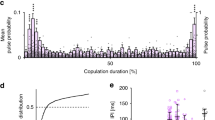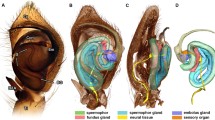Summary
Between two mating acts of the male cricket (Gryllus bimaculatus), spermatophore protrusion (SP) and courtship stridulation (CS), there is a fixed time interval. This interval lasts about 1 h. During the period from SP to CS, the male cricket does not stridulate nor make any type of mating sound (post-spermatophore protrusion silence: PSPS) and tolerates external sensory stimuli. We examined the effects of injections of hemolymph and ganglia extracts on the interval. Extracts obtained from crickets which had just started CS (CS crickets) and those which had finished SP (SP crickets) were effective. The extracts were fractionated by ul trafiltration. Fractions with a molecular weight of less than 1 kdalton affected the length of the PSPS. The fractions from both the hemolymph and the mesothoracic ganglion of CS crickets shortened the PSPS. On the other hand, the fractions from the hemolymph and the brain of SP crickets lengthened the PSPS. We estimated, by gel filtration, the molecular weight of the effective fractions from the mesothoracic ganglion and the brain to be 100–200 daltons. We also examined the effects of biogenic amines on the PSPS. Octopamine shortened the PSPS, whereas serotonin lengthened it. The results in dicate that at least two neurohormones from the brain and the mesothoracic ganglion reciprocally control the elicitation of CS and provide an appropriate interval in the mating sequence of the male cricket. Octopamine and serotonin are possible candidates for these neurohormones.
Similar content being viewed by others
Abbreviations
- CP :
-
copulation
- CS :
-
courtship stridulation
- SP :
-
spermatophore protrusion
- PSPS :
-
post-spermatophore protrusion silence
References
Alexander RD (1962a) The role of behavioral study in cricket classification. Syst Zool 11:53–72
Alexander RD (1962b) Evolutionary change in cricket acoustical communication. Evolution 16:443–467
Barth RH, Lester LJ (1973) Neurohormonal control of sexual behavior in insects. Ann Rev Entomol 18:455–472
Beaudet A, Descarries L (1978) The monoamine innervation of rat cerebral cortex: synaptic and nonsynaptic axon terminals. Neuroscience 3:851–860
Breen CA, Atwood HL (1983) Octopamine-a neurohormone with presynaptic activity-dependent effects at crayfish neuromuscular junctions. Nature 303:716–718
Claassen DE, Kammer AE (1986) Effects of octopamine, dopamine, and serotonin on production of flight motor output by thoracic ganglia of Manduca sexta. J Neurobiol 17:1–14
Coggershall RE (1978) A cytological analysis of the bag cell control of egg laying in Aplysia. J Morphol 132:461–485
Dismukes RK (1979) New concepts of molecular communication among neurons. Behav Brain Sci 2:409–448
Evans PD (1980) Biogenic amines in the insect nervous system. In: Berridge MJ, Treherne JE, Wigglesworth VB (eds) Advances in insect physiology, 15. Academic Press, London New York, pp 317–473
Evans PD (1982) Properties of modulatory octopamine receptors in the locust. In: Evered D, O'Connor M, Whelau J (eds) Neuropharmacology of insects. Ciba Foundation symposium 88. Pitman, London, pp 48–69
Evans PD (1984) Studies on the mode of action of octopamine, 5-hydroxytryptamine and proctolin on a myogenic rhythm in the locust. J Exp Biol 110:231–251
Evans PD, O'Shea M (1978) The identification of an octopaminergic neurone and the modulation of a myogenic rhythm in the locust. J Exp Biol 73:235–260
Goosey MW, Candy DJ (1980) The D-octopamine content of the haemolymph of the locust Schistocerca americana gregaria and its elevation during flight. Insect Biochem 10:393–397
Harris-Warrick RM, Kravitz EA (1984) Cellular mechanisms for modulation of posture by octopamine and serotonin in the lobster. J Neurosci 4:1976–1993
Hoyle G (1975) Evidence that insect dorsal unpaired median (DUM) neurons are octopaminergic. J Exp Zool 193:425–431
Hoyle G (1978) The dorsal, unpaired, median neurons of the locust metathoracic ganglion. J Neurobiol 9:43–57
Hoyle G (1984) Neuromuscular transmission in a primitive insect: modulation by octopamine, and catch-like tension. Comp Biochem Physiol 77C:219–232
Huber F (1955) Sitz und Bedeutung nervöser Zentren für Instinkthandlungen beim Männchen von Gryllus campestris L. Z Tierpsychol 12:12–48
Huber F (1960) Untersuchungen über die Funktion des Zentralnervensystems und insbesondere des Gehirnes bei der Fortbewegung und der Lauterzeugung der Grillen. Z Vergl Physiol 44:60–132
Huber F (1962) Central nervous control of sound production in crickets and some speculations on its evolution. Evolution 16:429–442
Kravitz EA (1988) Hormonal control of behavior: amines and the biasing of behavioral output in lobsters. Science 241:1775–1781
Kravitz EA, Glusman S, Harris-Warrick RM, Livingstone MS, Schwarz T, Goy MF (1980) Amines and a peptide as neurohormones in lobsters: actions on neuromuscular preparations and preliminary behavioural studies. J Exp Biol 89:159–175
Kutsch W, Otto D (1972) Evidence for spontaneous song production independent of head ganglia in Gryllus campestris L. J Comp Physiol 81:115–119
Livingstone MS, Harris-Warrick RM, Kravitz EA (1980) Serotonin and octopamine produce opposite postures in lobsters. Science 208:76–79
Loher W, Rence B (1978) The mating behavior of Teleogryllus commodus (Walker) and its central and peripheral control. Z Tierpsychol 46:225–259
Manning A (1966) Sexual behaviour. Symp R Entomol Soc Lond 3:59–68
Nagao T, Shimozawa T (1987) A fixed time-interval between two behavioural elements in the mating behaviour of male crickets, Gryllus bimaculatus. Anim Behav 35:122–130
Nagao T, Tanimura T (1988) Distribution of biogenic amines in the cricket central nervous system. Anal Biochem 171:33–40
Nagy F, Dickinson PS (1983) Control of a central pattern generator by an identified modulatory interneurone in Crustacea. I. Modulation of the pyloric motor output. J Exp Biol 105:33–58
Orchard I, Lange AB (1985) Evidence for octopaminergic modulation of an insect visceral muscle. J Neurobiol 16:171–181
O'Shea M, Evans PD (1979) Potentiation of neuromuscular transmission by an octopaminergic neurone in the locust. J Exp Biol 79:169–190
Otto D (1971) Untersuchungen zur zentralnervösen Kontrolle der Lauterzeugung von Grillen. Z Vergl Physiol 74:227–271
Pickel VM, Beckley SC, Joh TH, Reis DJ (1981) Ultrastructural immunocytochemical localization of tyrosine hydroxylase in the neostriatum. Brain Res 225:373–385
Raabe M (1986) Insect reproduction: regulation of successive steps. In: Evans PD, Wigglesworth VB (eds) Advances in insect physiology, vol. 19. Academic Press, London New York, pp 29–154
Sombati S, Hoyle G (1984) Generation of specific behaviors in a locust by local release into neuropil of the natural neuromodulator octopamine. J Neurobiol 15:481–506
Stuart DK, Strumwasser F (1980) Neuronal sites of action of a neurosecretory peptide, egg-laying hormone, in Aplysia californien. J Neurophysiol 43:499–519
Taghert PH, Truman JW, Reynolds SE (1980) Physiology of pupal ecdysis in the tobacco hornworm, Manduca sexta. J Exp Biol 88:339–349
Truman JW, Riddiford LM (1974) Hormonal mechanisms underlying insect behaviour. In: Treherne JE, Berridge MJ, Wigglesworth VB (eds) Advances in insect physiology, vol. 10. Academic Press, London New York, pp 297–352
Author information
Authors and Affiliations
Rights and permissions
About this article
Cite this article
Nagao, T., Tanimura, T. & Shimozawa, T. Neurohormonal control of the mating interval in the male cricket, Gryllus bimaculatus DeGeer. J Comp Physiol A 168, 159–164 (1991). https://doi.org/10.1007/BF00218408
Accepted:
Issue Date:
DOI: https://doi.org/10.1007/BF00218408




